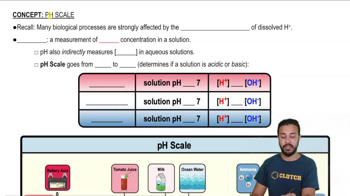Table of contents
- 1. Introduction to Biology2h 42m
- 2. Chemistry3h 40m
- 3. Water1h 26m
- 4. Biomolecules2h 23m
- 5. Cell Components2h 26m
- 6. The Membrane2h 31m
- 7. Energy and Metabolism2h 0m
- 8. Respiration2h 40m
- 9. Photosynthesis2h 49m
- 10. Cell Signaling59m
- 11. Cell Division2h 47m
- 12. Meiosis2h 0m
- 13. Mendelian Genetics4h 44m
- Introduction to Mendel's Experiments7m
- Genotype vs. Phenotype17m
- Punnett Squares13m
- Mendel's Experiments26m
- Mendel's Laws18m
- Monohybrid Crosses19m
- Test Crosses14m
- Dihybrid Crosses20m
- Punnett Square Probability26m
- Incomplete Dominance vs. Codominance20m
- Epistasis7m
- Non-Mendelian Genetics12m
- Pedigrees6m
- Autosomal Inheritance21m
- Sex-Linked Inheritance43m
- X-Inactivation9m
- 14. DNA Synthesis2h 27m
- 15. Gene Expression3h 20m
- 16. Regulation of Expression3h 31m
- Introduction to Regulation of Gene Expression13m
- Prokaryotic Gene Regulation via Operons27m
- The Lac Operon21m
- Glucose's Impact on Lac Operon25m
- The Trp Operon20m
- Review of the Lac Operon & Trp Operon11m
- Introduction to Eukaryotic Gene Regulation9m
- Eukaryotic Chromatin Modifications16m
- Eukaryotic Transcriptional Control22m
- Eukaryotic Post-Transcriptional Regulation28m
- Eukaryotic Post-Translational Regulation13m
- 17. Viruses37m
- 18. Biotechnology2h 58m
- 19. Genomics17m
- 20. Development1h 5m
- 21. Evolution3h 1m
- 22. Evolution of Populations3h 52m
- 23. Speciation1h 37m
- 24. History of Life on Earth2h 6m
- 25. Phylogeny2h 31m
- 26. Prokaryotes4h 59m
- 27. Protists1h 12m
- 28. Plants1h 22m
- 29. Fungi36m
- 30. Overview of Animals34m
- 31. Invertebrates1h 2m
- 32. Vertebrates50m
- 33. Plant Anatomy1h 3m
- 34. Vascular Plant Transport1h 2m
- 35. Soil37m
- 36. Plant Reproduction47m
- 37. Plant Sensation and Response1h 9m
- 38. Animal Form and Function1h 19m
- 39. Digestive System1h 10m
- 40. Circulatory System1h 57m
- 41. Immune System1h 12m
- 42. Osmoregulation and Excretion50m
- 43. Endocrine System1h 4m
- 44. Animal Reproduction1h 2m
- 45. Nervous System1h 55m
- 46. Sensory Systems46m
- 47. Muscle Systems23m
- 48. Ecology3h 11m
- Introduction to Ecology20m
- Biogeography14m
- Earth's Climate Patterns50m
- Introduction to Terrestrial Biomes10m
- Terrestrial Biomes: Near Equator13m
- Terrestrial Biomes: Temperate Regions10m
- Terrestrial Biomes: Northern Regions15m
- Introduction to Aquatic Biomes27m
- Freshwater Aquatic Biomes14m
- Marine Aquatic Biomes13m
- 49. Animal Behavior28m
- 50. Population Ecology3h 41m
- Introduction to Population Ecology28m
- Population Sampling Methods23m
- Life History12m
- Population Demography17m
- Factors Limiting Population Growth14m
- Introduction to Population Growth Models22m
- Linear Population Growth6m
- Exponential Population Growth29m
- Logistic Population Growth32m
- r/K Selection10m
- The Human Population22m
- 51. Community Ecology2h 46m
- Introduction to Community Ecology2m
- Introduction to Community Interactions9m
- Community Interactions: Competition (-/-)38m
- Community Interactions: Exploitation (+/-)23m
- Community Interactions: Mutualism (+/+) & Commensalism (+/0)9m
- Community Structure35m
- Community Dynamics26m
- Geographic Impact on Communities21m
- 52. Ecosystems2h 36m
- 53. Conservation Biology24m
6. The Membrane
Simple and Facilitated Diffusion
Problem 5`
Textbook Question
Based on Figure 7.18, which of these experimental treatments would increase the rate of sucrose transport into a plant cell?
a. Decreasing extracellular sucrose concentration
b. Decreasing extracellular pH
c. Decreasing cytoplasmic pH
d. Adding a substance that makes the membrane more permeable to hydrogen ions
 Verified step by step guidance
Verified step by step guidance1
Understand the mechanism of sucrose transport in plant cells, which often involves a symport system where sucrose is transported along with hydrogen ions (H⁺) across the cell membrane.
Consider how the concentration gradient of hydrogen ions affects the transport rate. A higher concentration of H⁺ outside the cell can drive the symport process more effectively.
Evaluate the effect of extracellular pH on hydrogen ion concentration. Lowering the extracellular pH increases the concentration of H⁺ ions outside the cell, potentially enhancing the symport of sucrose.
Analyze the impact of cytoplasmic pH. Decreasing cytoplasmic pH would increase H⁺ concentration inside the cell, potentially disrupting the gradient needed for effective symport.
Consider the role of membrane permeability to hydrogen ions. Increasing permeability could facilitate the movement of H⁺ ions, thereby enhancing the sucrose transport rate if the gradient is favorable.
 Verified video answer for a similar problem:
Verified video answer for a similar problem:This video solution was recommended by our tutors as helpful for the problem above
Video duration:
1mPlay a video:
Was this helpful?
Key Concepts
Here are the essential concepts you must grasp in order to answer the question correctly.
Sucrose Transport Mechanism
Sucrose transport into plant cells typically occurs via active transport mechanisms, often involving sucrose-proton symporters. These transporters use the proton gradient across the membrane to facilitate the movement of sucrose into the cell against its concentration gradient. Understanding how these symporters function is crucial for predicting how changes in environmental conditions might affect sucrose transport.
Recommended video:
Guided course

Active Transport
Proton Gradient and pH
The proton gradient across the cell membrane is essential for many transport processes, including sucrose transport. The gradient is influenced by the pH levels inside and outside the cell; a lower extracellular pH can increase the proton concentration outside the cell, enhancing the gradient. This gradient is a driving force for symporters that couple sucrose transport with proton movement, making pH manipulation a key factor in transport rate changes.
Recommended video:
Guided course

pH Scale
Membrane Permeability
Membrane permeability refers to the ability of substances to pass through the cell membrane. Altering the permeability to specific ions, such as hydrogen ions, can significantly impact the proton gradient and thus affect transport processes. Increasing membrane permeability to protons can disrupt the gradient, potentially enhancing or inhibiting the transport of molecules like sucrose, depending on the direction and magnitude of the change.
Recommended video:
Guided course

Introduction to Membrane Transport

 5:10m
5:10mWatch next
Master Simple and Facilitated Diffusion with a bite sized video explanation from Jason
Start learningRelated Videos
Related Practice











